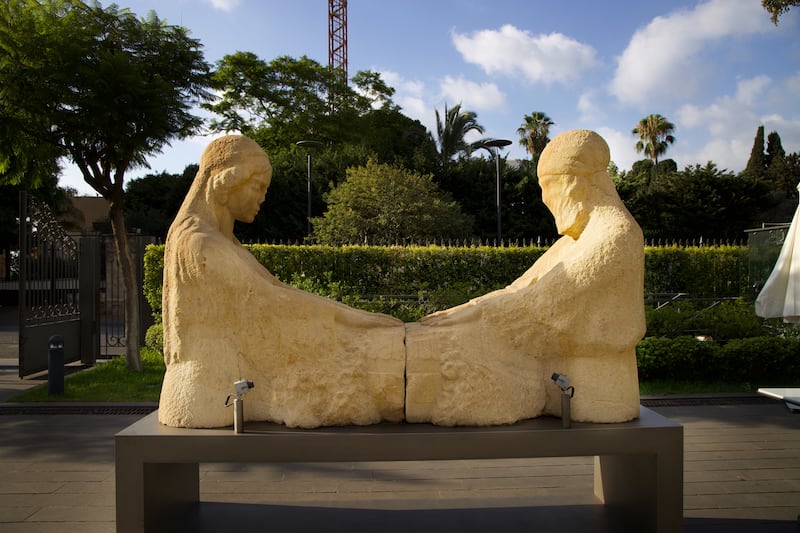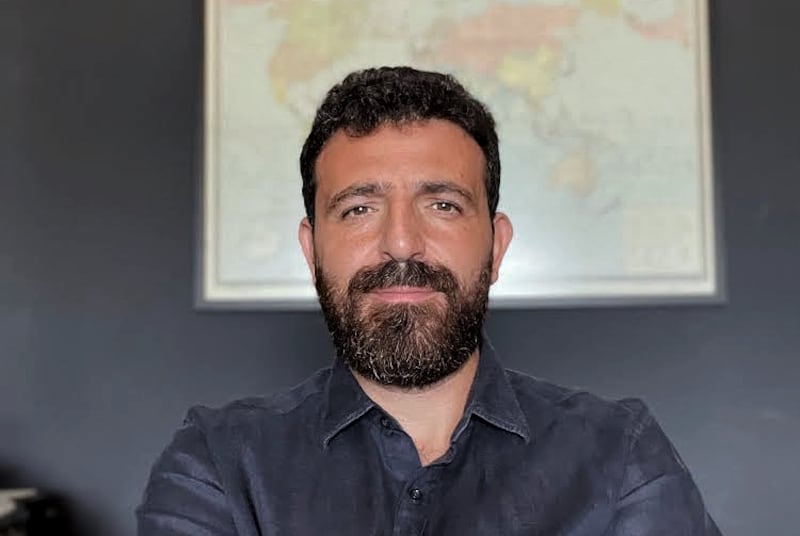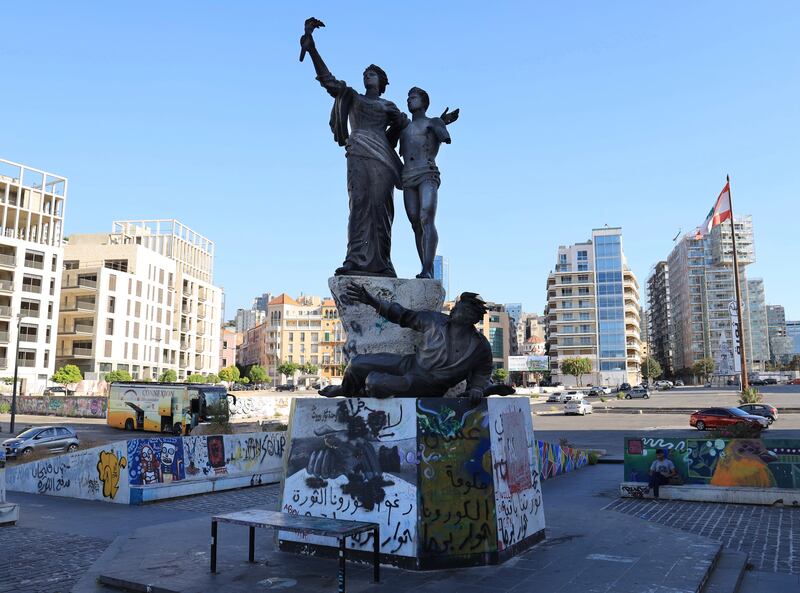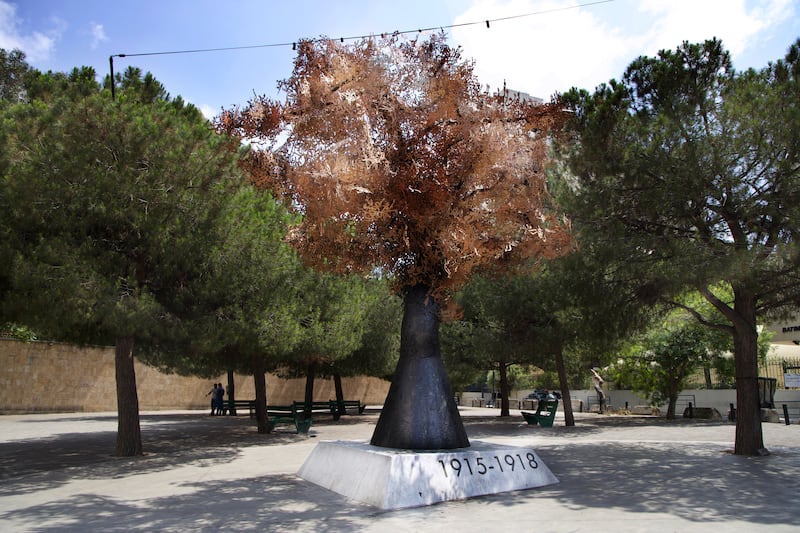A painted steel tree in central Beirut with “1915-1918″ inscribed on its base is the sole memorial to the Great Famine that decimated the population of Mount Lebanon during the first World War. “It is said that the Lebanese suffer from collective amnesia,” writes Yazan Halwani, the artist behind The Memory Tree famine memorial. “Only the trees can bear witness to the events that occurred.”
The words of Lebanese writers such as Gibran Khalil Gibran form the “leaves” of the tree. “They are the literal memories of those artists and writers who shared the famine with the world,” writes Tylor Brand at the end of his new book on the crisis, Famine Worlds.
There was once another public memorial to the famine in Beirut: a statue devised by Youssef Hoyek in 1930 featuring a Muslim and a Christian mother mourning the loss of their children from wartime hunger and conflict.
Brand, an assistant professor of Near and Middle Eastern Studies at Trinity College Dublin, writes that, at the time, the statue was criticised for symbolising “tears and resignation, rather than courage and heroism”, while another critic said that the “disgrace” of the famine should be collectively forgotten, not commemorated.
READ MORE

Even if the lower estimate is accurate, the famine in Lebanon would involve a higher percentage of the population dying than in the Ethiopian famine from 1983-1985 or the Indian famine from 1943-1944
After being vandalised, Hoyek’s statue and its display of maternal mourning were replaced by a depiction of men executed in Beirut in 1916 on the orders of Jamal Pasha, the much-loathed Ottoman leader who oversaw the autonomous region of Mount Lebanon. The muscular artwork by Italian artist Marino Mazzacurati installed in 1960 reveals a defiant narrative of Lebanon’s history, with little reference to the devastating loss of life the region was experiencing at the time from hunger and disease.
Death figures for the famine range from 80,000 to more than 200,000 (about 20-50 per cent of Lebanon’s 1914 population). “Evading the Ottoman census was a proud tradition for people across the region,” Brand explains to The Irish Times, so attempting to estimate death figures based on census data is “meaningless” because of how unreliable it is. But even if the lower estimate is accurate, the famine in Lebanon would, on a per capita basis, be “one of the worst disasters in the 20th century”, says Brand, and involve a higher percentage of the population dying than in the Ethiopian famine from 1983-1985 or the Indian famine from 1943-1944.
Brand’s book began as an environmental history of the famine while he was completing his PhD at the American University of Beirut (AUB), but as he began reviewing memoirs, letters and diaries from the 1910s, an influx of Syrian refugees arrived in Beirut to escape the war that began in [2010] in neighbouring Syria – “I began to walk down the streets and see a mother holding an unconscious child or a three-year-old begging”.
Brand’s own experience “on the edge of suffering” altered his approach to the book; it became an examination of the mental heuristics people deployed during the famine – “the crisis changed how society had begun to regard human bodies, death and the dead”.

“As time passed, individuals and communities began to rationalise death’s presence in their worlds and to adjust how they dealt with the emotional and practical burdens that it placed on them,” writes Brand. “Rather than seeking to address the suffering, people became desensitised to the plight of the poor, and some sought to excise them from their daily experience altogether.”
Jirjis Khuri Maqdisi, a professor at AUB’s precursor, the Syrian Protestant College, wrote during the famine: “In 1915, the sight of a starving man falling would cause people to surround him and give him some water, some food and some dirhams.” By 1916, most people would walk by children lying in the mud crying out for bread – “most frequently, on passing, people turned their face and blocked their ears so they could not see or hear”.
Lebanon’s latest economic crisis has pushed 80 per cent of the population below the poverty line and last year, Brand read Maqdisi’s passage to a class he taught at AUB. “It was stunning how many of the people in the classroom saw themselves in the responses to the crisis these people had,” he says.
The school history curriculum addresses the famine only briefly and emphasises the Ottoman’s culpability and that they deliberately starved the Lebanese to subdue them.

“This narrative was developed during the French mandate,” says Charles Al-Hayek, a historian who taught at a school in Lebanon for 20 years, “and it removes the blame from one of the main actors of the famine: the merchants of Beirut and Mount Lebanon, who profited enormously from holding and selling wheat at high prices . . . The same elite families that contributed to the famine are still in power today and there is complete silence on their responsibility.”
“The Ottomans bear a large part of the responsibility, but they did not engineer the famine,” says Hayek who runs Heritage and Roots, a public history platform.
The region’s food supplies were strangled in 1914 by a coastal blockade enforced by the Allied powers that prevented port cities from trading cash crops such as silk and tobacco for much-needed food; while a land blockade imposed by the Ottomans to prevent smuggling in the mountain areas pushed food prices higher and encouraged corruption. Unemployment spiralled and a swarm of locusts in 1915 destroyed many crops in the region.
The Ottoman government’s heavy-handed attempts to limit inflation and spiralling prices failed to stop black market speculation and by 1918 the local currency had lost 80 per cent of its value. As the quality and quantity of food deteriorated during the famine, people became more vulnerable to diseases such as typhus, malaria and tuberculosis; while those who moved from their villages to urban centres had little social support if they fell ill.

Today, Lebanon’s Christian Maronite community widely believes that they were specifically targeted by the Muslim Ottomans but “the historical evidence shows that the Lebanese Christians were one of the most dynamic and autonomous Christian communities in the Ottoman Empire”, says Hayek. Other communities suffered greatly, particularly the Shia Muslims, who faced discrimination from the Sunni Muslim Ottomans.
After the first World War, the famine was rapidly weaponised. At the Paris Peace Conference where the victorious Allied powers set the terms for peace, the Maronite religious leader, Elias Howayek, successfully used the disaster to make the case for a Christian-dominated state under French protection. To make this state more self-sufficient in the event of another blockade, its territory was expanded to include agricultural zones in northern Akkar, the eastern Bekaa Valley and the Shia-dominated hills of Jabal Amel in the south – despite many Muslims there having little desire to be part of the new state.
“The issue of memory with a famine is such a complicated one because people have the need to maintain this proprietary control over the narrative,” says Brand. “People often learn about the famine from their family and they trust this historical heritage that they’re given” – when that’s challenged it can be traumatic.
Brand plans to start an oral history project that captures familial and community memories of the famine before they are lost – “they can become part of a collective memory and people can see the connections across society in ways they didn’t before”.






















